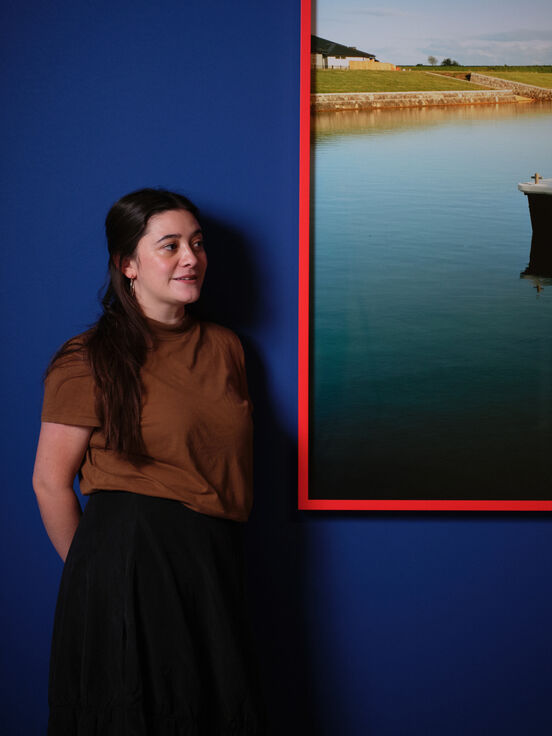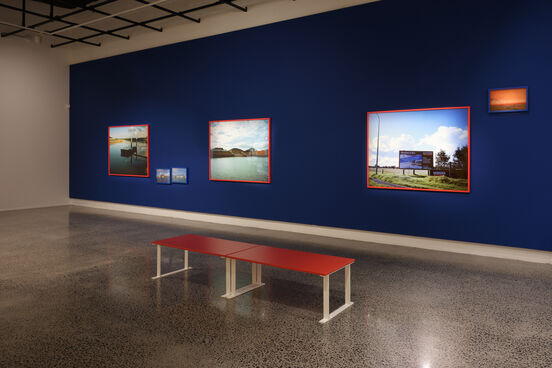Interview with Ngahuia Harrison
Ngahuia Harrison: I te taha o tōku Pāpā, nō Te Waipounamu ahau, he Pākehā ahau. I te taha o tōku Māmā nō Te Taitokerau ahau, ko Ngātiwai, Ngāpuhi, Ngāti Pukenga ōku iwi.
This project, Coastal Cannibals, has come out of my doctoral research. I began looking at the effects of the Marine and Coastal Area (Takutai Moana) Act 2011 upon my iwi, Ngātiwai. The research has morphed into looking at everything that falls outside of the narrow definition the Crown has created to tell Māori how we relate to the sea and coastline. As well as all of the fronts we fight on to protect not only our relationship to the moana, but the moana itself.
Objectspace: The exhibition was catalysed by the idea of hostile architecture. This provocation suggests that our experience of the built environment and place can be fraught – in a state of tension that prioritises some people’s needs over others’, and at odds with the natural world. What experiences do you have of hostile architecture in your daily life?
NH: My work looks at ideas of property – how we own things and how this understanding of ownership is so different from place to place and person to person. When we look at land, anywhere in Aotearoa, it’s a constant reminder that all of the whenua in what is now New Zealand was in Māori possession, under care of hapū, at some point. It belonged to hapū and now, for different reasons, it doesn’t. I think that is hostile, that reminder. Of course there are numerous losses tied up in that primary loss of land. The reminder that enclosure of common lands started the process of colonisation. For Māori, when your being and consciousness is so tied up in that whenua, you are losing a lot more than a pile of dirt. So for me looking at our coast, Te Akau Roa o Ngātiwai, and the developments, the industry, even the marine reserves – they are hostile to our occupation as well as our continued attempts at reclamation.
OS: Tell us more about your work for Toro Whakaara.
NH: I’ve been working on Coastal Cannibals for the past three years and I’m constantly adding to it. The series focuses on the Whangārei Harbour, Whangārei Te Rerenga Parāoa, and the heavy industry established on and around the place, including residential housing developments. The heavy industry are places like the oil refinery, the Portland cement works, the Limestone works, the marinas – all these things gobbling up our environment and our moana. Some of the residential developments around Ruakākā and Marsden Point have carved out the land to channel the moana, creating canals so people can have their own jetty to park their boats like they park their cars. For coastal and ocean tribes, the moana is an important and significant place – the ocean is everything. To see it being used in this way is very frustrating – it’s taking and using our land in a way that assumes our interests have been extinguished. They haven’t. Still in our very present and real time of climate crisis it is mind-blowing how little respect there is for land, sea and waterways.
OS: What drew you to investigating this site?
NH: Initially, I was looking at the oil refinery. When you come over the Brynderwyn Hills, you see Mount Manaia, Whangārei, and the other landmark is the refinery – those chimneys are just as much of a signal of home for me. There’s a beauty to it. My grandfather helped build the original chimneys, my uncles and dad worked on the team that took them down, my cousins put the new ones up. The oil refinery became this sort of mythical place for me in my own head or in family folklore. There was this frontier vibe about it – everyone had stories about what happened there, what they had experienced. There were stories about the workers’ strikes, injuries, close calls. My cousin described the long line of buses that would leave Whangārei early morning and weave like a glittering snake all the way out to the Point. My cousin, always the rebel, wouldn’t take the bus – instead driving at full speed alongside them, dipping in and out between the buses and oncoming traffic. At its peak the Point employed 5000 people.
OS: The site is at an intersection between rural, commercial, heavy industrial and residential use and also recreational use – through your explorations you would have seen how impactful these uses are to the whenua. What would you like to see happen in the future?
NH: The housing developments that are being built are basically creating desert villages. There’s no public transport, no social infrastructure, no community, no basic services. You have to drive for at least half an hour to get anything. But they are sold to people as an inspirational dream home. One hope is that these types of developments are scrutinised more, so we think more about how people are actually going to live in a place and planning is considered more in depth so the dependency on cars isn’t there and community connection can thrive. But at a wider level, it’s the sprawl that’s the scary thing, the development that keeps inching over the coast and taking away access and connection to the moana. I’m hoping that the sprawl is what stops and the development along the coast eases. With sea levels on the up and up, you sort of think it would have to. I mean at the moment, the other major coastal cannibal is the sea!
This text is republished from Toro Whakaara: Responses to our built environment, a publication produced by Objectspace to accompany an exhibition of the same name. The publication is edited by Tessa Forde, and copy-edited by Anna Hodge.

Ngahuia Harrison pictured with her work. Photograph by Seb Charles.

Ngahuia Harrison, Coastal Cannibals, ongoing. Installation view in Toro Whakaara: Responses to our built environment presented by Architectus. Photograph by Sam Hartnett.